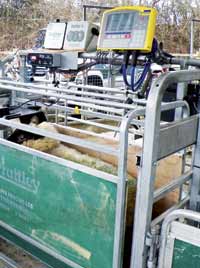EID can make a real difference

Whether UK sheep farmers like it or not, electronic identification is here to stay. And while no-one wanted to see EID made compulsory, there are benefits of embracing such technology.
And now is the time to start planning how to incorporate EID into flocks, said ADAS sheep specialist Kate Phillips. Speaking at an EID meeting organised by Livestock Health South East, Ms Phillips stressed the importance of gathering information.
“It’s important to get as much information as possible before buying anything and don’t rush in to it immediately,” she said. She advised farmers attending the NFU-sponsored meeting to talk to markets and abattoirs about tag reading facilities (Central Point Recording of Electronic Devices).
“Some EID set-ups can cost in excess of £10,000, but you only need to buy kit you will use regularly. In some cases the only thing that may be needed are electronic tags and a handheld reader.”
However, the saying “you only get out what you put in” really rings true with EID, with benefits far outweighing the costs, according to Westpoint Vet Group’s Hugh Thomson.
“There are many benefits to be gained from using EID. You can get more detailed records of your flock, performance can be monitored and in doing so flocks could become more productive. When you are going to invest you may as well use it as an opportunity to input data and make changes to drive the flock forward.”
And demonstrating how EID can really make a difference in a flock was Sussex sheep farmer Matt Blyth.
He has been using EID for the past three years on his farm in Didling, West Sussex, and would encourage others to embrace the technology.
“EID can really make a difference to the way a flock is managed. It takes a lot of guessing out of things and it forces you to start monitoring.
Mr Blyth uses a fully integrated system, incorporating handheld and stick readers, dataloggers, an all-round race reader fixed to the weigh crate, a weigh head and automatic shedding system.
“The equipment you invest in is important. For example, handhelds are good at lambing where you can quickly record information such as how many lambs born to a ewe, but race readers are a faster way to gather information and are useful when there are large numbers of animals on farm.”
Since using EID Mr Blyth said he now finishes more accurately, has lowered costs and increased production rate.
“Take worming as an example, we have reduced the worming bill by 40% using EID. When lambs are not putting on adequate weight we will draft individuals and worm them. Also by separating lambs off according to weight, it allows feeding regimes to be targeted, with some being fed harder than others.”
Mr Blyth also struggled to finish lambs off at grass. “Because we can link lamb weights to specific pastures we know which fields perform well and can see where things are going wrong. So now by using specific pastures we can finish between 400-500 lambs off grass pre-weaning,” he said.
And it’s not just obvious things such as different grazing or feeding regimes that can affect weight. By inputting data Mr Blyth has discovered even the smallest management practices can have a significant impact on weight.
“I have discovered I can get an extra 1.5kg of growth by taking wool off Southdowns but for Lleyn shearlings the reverse situation occurred, so this year we have not sheared these individuals,” he said.
And EID has also resulted in a change of breeding policy at Didling Farm. “Before we were using Texels and Beltexes in the commercial flock and although they would look good, when we looked at the data we could see they just weren’t performing on our system. This is why we have now started using Southdowns and Lleyns and will also be incorporating some Meatlinc.”
Mr Blyth also urges farmers to request information back from abattoirs, as weights can be linked to tag numbers and areas for improvements identified.
Having a fully integrated EID system can also bring about labour savings, at a cost Mr Blyth equates to £23,000. “Because weighing lambs now takes less time, we have laid off a member of staff and saved a wage at a cost of £23,000.”
| For more information and a video about EID options visit www.fwi.co.uk/eidvid
